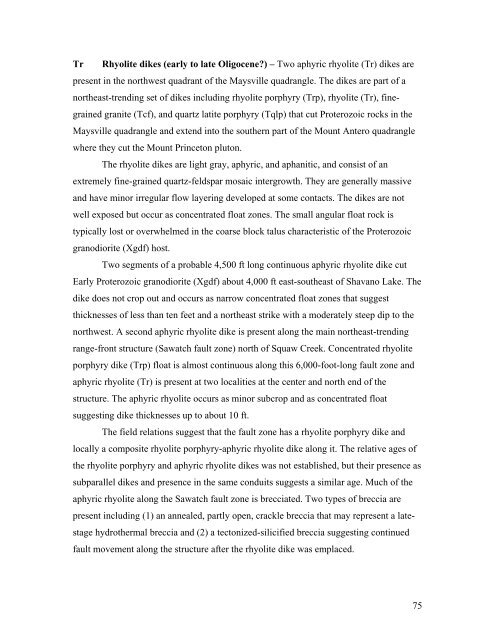Geologic Map of the Maysville Quadrangle, Chaffee County, Colorado
Geologic Map of the Maysville Quadrangle, Chaffee County, Colorado
Geologic Map of the Maysville Quadrangle, Chaffee County, Colorado
Create successful ePaper yourself
Turn your PDF publications into a flip-book with our unique Google optimized e-Paper software.
Tr Rhyolite dikes (early to late Oligocene) – Two aphyric rhyolite (Tr) dikes are<br />
present in <strong>the</strong> northwest quadrant <strong>of</strong> <strong>the</strong> <strong>Maysville</strong> quadrangle. The dikes are part <strong>of</strong> a<br />
nor<strong>the</strong>ast-trending set <strong>of</strong> dikes including rhyolite porphyry (Trp), rhyolite (Tr), finegrained<br />
granite (Tcf), and quartz latite porphyry (Tqlp) that cut Proterozoic rocks in <strong>the</strong><br />
<strong>Maysville</strong> quadrangle and extend into <strong>the</strong> sou<strong>the</strong>rn part <strong>of</strong> <strong>the</strong> Mount Antero quadrangle<br />
where <strong>the</strong>y cut <strong>the</strong> Mount Princeton pluton.<br />
The rhyolite dikes are light gray, aphyric, and aphanitic, and consist <strong>of</strong> an<br />
extremely fine-grained quartz-feldspar mosaic intergrowth. They are generally massive<br />
and have minor irregular flow layering developed at some contacts. The dikes are not<br />
well exposed but occur as concentrated float zones. The small angular float rock is<br />
typically lost or overwhelmed in <strong>the</strong> coarse block talus characteristic <strong>of</strong> <strong>the</strong> Proterozoic<br />
granodiorite (Xgdf) host.<br />
Two segments <strong>of</strong> a probable 4,500 ft long continuous aphyric rhyolite dike cut<br />
Early Proterozoic granodiorite (Xgdf) about 4,000 ft east-sou<strong>the</strong>ast <strong>of</strong> Shavano Lake. The<br />
dike does not crop out and occurs as narrow concentrated float zones that suggest<br />
thicknesses <strong>of</strong> less than ten feet and a nor<strong>the</strong>ast strike with a moderately steep dip to <strong>the</strong><br />
northwest. A second aphyric rhyolite dike is present along <strong>the</strong> main nor<strong>the</strong>ast-trending<br />
range-front structure (Sawatch fault zone) north <strong>of</strong> Squaw Creek. Concentrated rhyolite<br />
porphyry dike (Trp) float is almost continuous along this 6,000-foot-long fault zone and<br />
aphyric rhyolite (Tr) is present at two localities at <strong>the</strong> center and north end <strong>of</strong> <strong>the</strong><br />
structure. The aphyric rhyolite occurs as minor subcrop and as concentrated float<br />
suggesting dike thicknesses up to about 10 ft.<br />
The field relations suggest that <strong>the</strong> fault zone has a rhyolite porphyry dike and<br />
locally a composite rhyolite porphyry-aphyric rhyolite dike along it. The relative ages <strong>of</strong><br />
<strong>the</strong> rhyolite porphyry and aphyric rhyolite dikes was not established, but <strong>the</strong>ir presence as<br />
subparallel dikes and presence in <strong>the</strong> same conduits suggests a similar age. Much <strong>of</strong> <strong>the</strong><br />
aphyric rhyolite along <strong>the</strong> Sawatch fault zone is brecciated. Two types <strong>of</strong> breccia are<br />
present including (1) an annealed, partly open, crackle breccia that may represent a latestage<br />
hydro<strong>the</strong>rmal breccia and (2) a tectonized-silicified breccia suggesting continued<br />
fault movement along <strong>the</strong> structure after <strong>the</strong> rhyolite dike was emplaced.<br />
75




